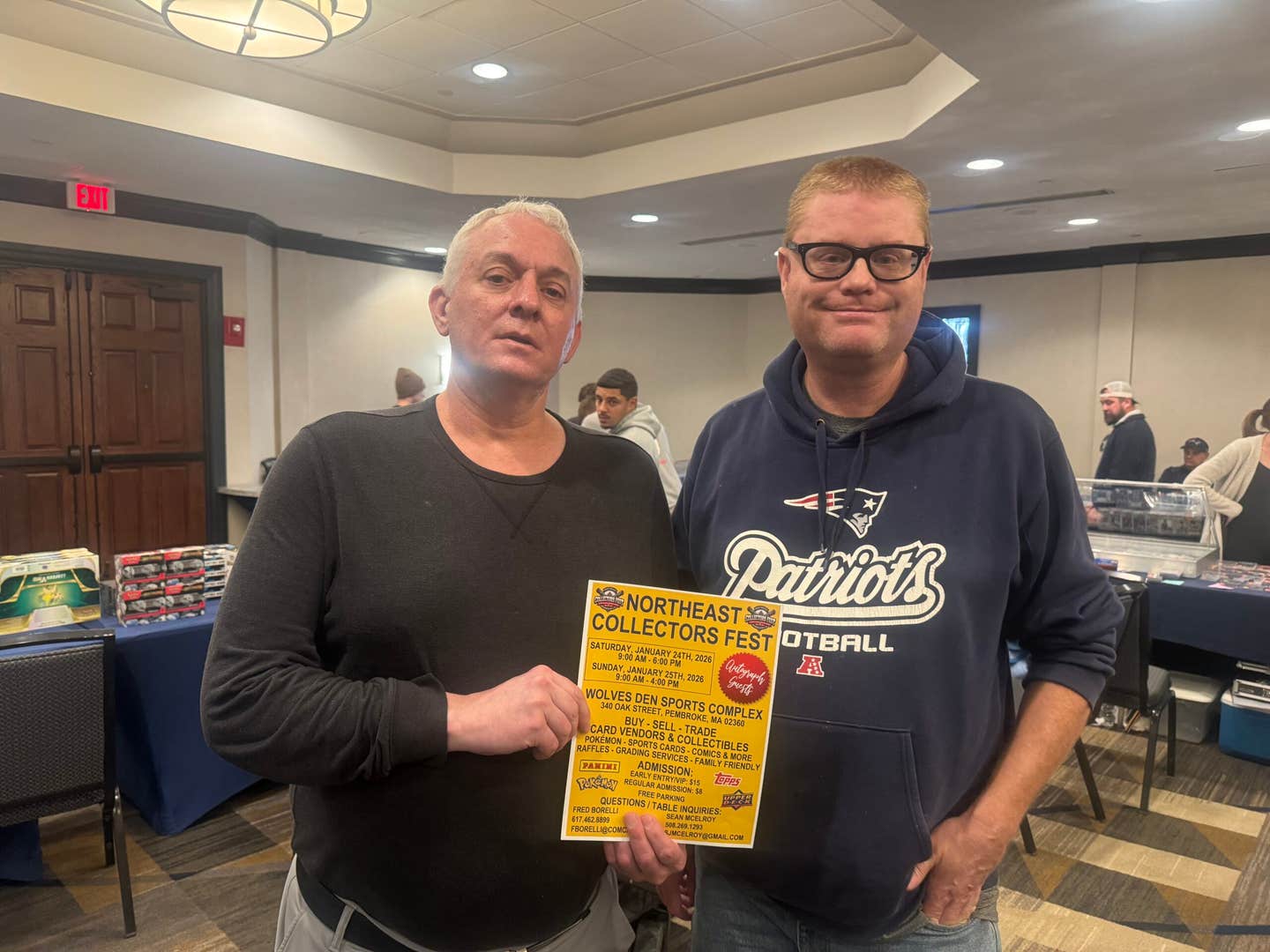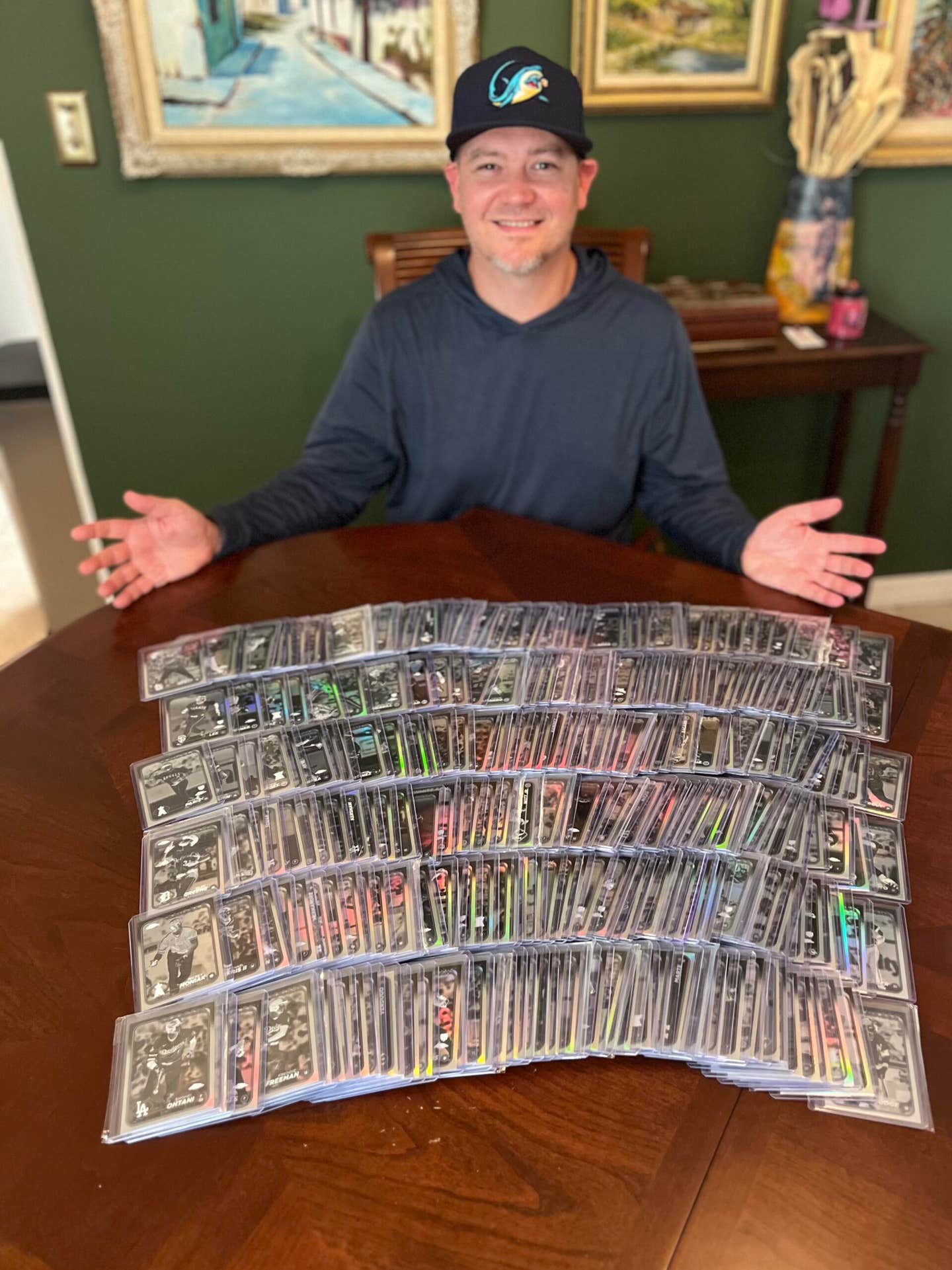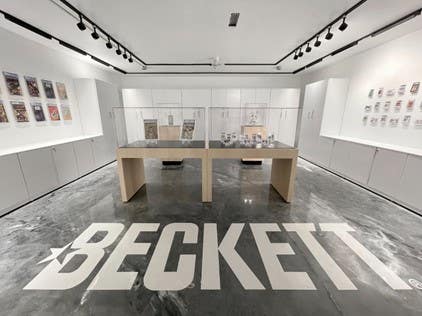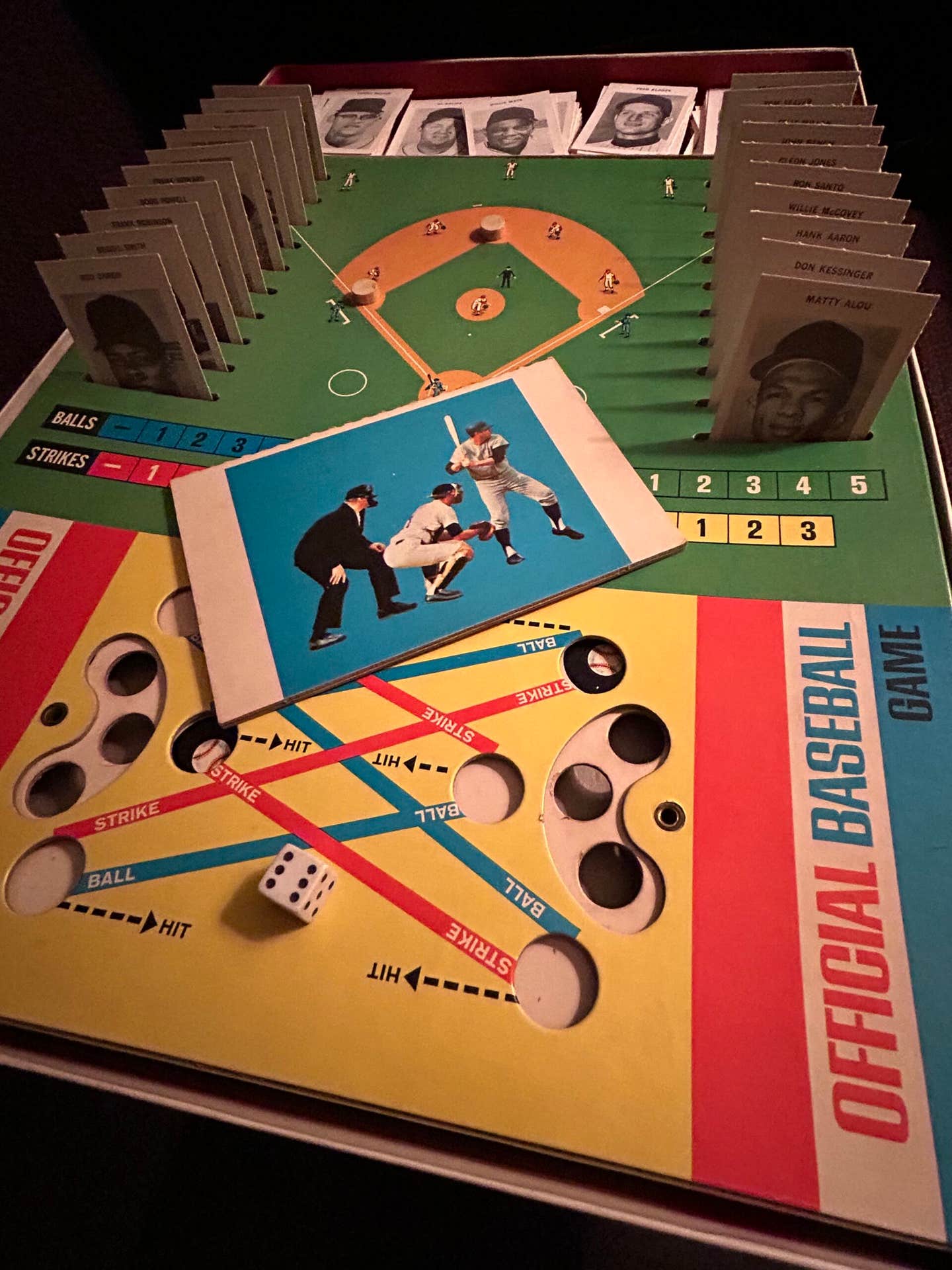Featured
A Tale of the Yellow Back: 1968 Milton Bradley Set
By Dr. Carlton Miller
PART 1: THE PRODUCTION
Beginnings
I remember that hot Charlotte summer night in 1968 just like it was yesterday. Dad grinned broadly as my brother and I joyously ripped open his new present, a Milton Bradley board game called Win a Card. Instead of nickel wax packs with five cards, this was a toy with dozens of cards! Up until that night, we thought we were the only kids in Braves country that missed out on getting a 1968 Aaron. Now we had three! We didn’t know then that the Topps 2nd Series cards were long gone from the shelves – those were the last Aarons we would see that year.
RFK Stadium wasn’t far from home, and the Senators were our second team. That meant the Nats and Braves cards got their own special shoebox. I studied those cards endlessly. Over time, I noticed the three Casey Cox cards from that game looked like normal Senators cards, with yellow letters in a green circle. The other ’68 Coxes I had gotten earlier that year looked strange, being the only Senators cards with white letters. I remember almost taking a yellow marker to them. I was left to wonder why those Eddie Brinkman and Casey Cox ’68 cards looked different than Ken McMullen or Frank Howard.
Years passed and the hobby exploded. By 1990, I had collected a dozen Brinkman/Cox and yellow type cards, and realized all yellow type cards were Milton Bradley cards with those distinctive yellow backs. As I re-examined the baseball, football and hot rod cards from my childhood collection, I saw that all the cards from my old game had yellow backs.
The game Dad bought me had a typical poor distribution, with three-to-four of most of the cards, and not a lot of singles. It was easy to conclude that all yellow type cards came from the Win a Card game and that those card backs were distinctive. After decades of collecting, with more than 40 total Brinkman/Cox cards and 3,300 Milton Bradley cards, it’s time to tell the full story behind this set.
Milton Bradley and Jim Shea
The Milton Bradley company was on its heels at the outbreak of WWII. James Shea Sr. stepped in as CEO, saving the company with debt restructure and adapting manufacturing for the war effort.
Postwar America boomed in prosperity; board games were extremely popular. Twister was the rage after Eva Gabor and Johnny Carson famously gyrated together, demonstrating the game on the Tonight Show in 1966.
As Shea prepared to retire in 1968, Milton Bradley was at it peak and in a swirl of activity. The company’s new East Longmeadow, Mass., production plant had just opened a year earlier, and after years of negotiation, a merger with Playskool took place in late 1968. These legal negotiations consumed the company.
A former sandlot player and lifelong baseball fan, Shea left his company with two personal touches. He designed the game Sandlot Slugger, featuring a plastic batter, in late 1967 for release the following year. He then turned to trading cards – with Topps still holding the monopoly on that profitable slice of childhood.
Two American giants
Shea approached Topps in late 1967 with a proposal to use their cards in a Milton Bradley board game. Precise details of the deal aren’t available in the Milton Bradley archives, but a now-retired Milton Bradley vice president told me years ago “there was a big rush to get things done before the Toy Fair.”
The 76th International Toy Fair opened in New York on Feb. 16, 1968, the annual industry high point. Here ideas were exchanged with retailers, beginning anew the post-Christmas toy and game cycle. The Milton Bradley executives brought their usual slick, 100-page catalog. As usual, most games listed had been on the market, with a few new ones. With the sweeping changes at Milton Bradley, their 1968 catalog was a little less polished than usual.
The page promoting the new “Win a Card” game in the 1968 catalog is striking for what it didn’t say at the bottom: “AS ADVERTISED ON TV.” By 1968, only a handful of Milton Bradley games were not advertised via TV. The lack of TV advertising for the Win a Card game was, in the words of one Milton Bradley employee, “The kiss of death.”
Production and assembly
Upon returning from NYC, Milton Bradley executives stuck with the same plan they had hatched with Topps. Their catalog promo sheet promised “a supply of 100 cards.” The production sheet held 12 rows of 11 cards: Four rows (44 cards) of 1968 1st Series baseball cards, three rows (33 cards) of 1968 2nd Series baseball cards, three rows (33 cards) of 1967 Topps football cards and two rows (22 cards) of Topps Hot Rod cards.
The regular Topps ’67 football and ’68 baseball cards shared the same goldenrod color back. Produced in collaboration with George Barris (designer of the Batmobile, etc.), the Hot Rod cards debuted in 1964 with pink/salmon backs and were re-released a few years later with orange backs as part of a Topps non-sport combo issue.
Topps and Milton Bradley wanted the variety of the three types of cards. Topps made sure the game front suggested “use these, or cards from your personal collection.” The aim, after all, was to sell more cards. The game design was simple, and uninspired – the random landing of a spinner determined who would pick up the most cards and win the game. You couldn’t play the game without handing the cards repeatedly. Card condition was of no concern to a 10-year-old in 1968.
Why these particular rows of cards were chosen and who selected them remains a mystery to this day.
Hobby veteran Dave Hornish believes the cards were printed in Philadelphia by the Zabel Brothers Co., then transported to East Longfellow where Milton Bradley packaged them. Once the cards left Topps, they didn’t come back. When Topps opened its vaults in 1989 for auction, no Milton Bradley cards or proof sheets were offered. I have contacted Topps since then, but no one has able to find any further records.
The outside of the Win a Card box promises a “generous supply of cards.” I have personally opened six games and have information from many other game openings.
The number of cards per game ranges from 86-105 cards, with an average in the
mid-90s. No game, therefore, has a full set of 132 cards. The cards are tightly placed in a small cardboard tray with four recesses, each capable of holding 30 cards. Each of the four card stacks of cards is bound by at least one rubber band, typically causing an indentation for several cards at the top and bottom of the stack. Some rubber bands are thicker than others. The tray is shrink-wrapped with the same brittle cellophane common to that era of Milton Bradley games. The only piece inside is a game board and spinner. The instructions, like all Milton Bradley games, are printed on the inner lid. The entire game is wrapped in cellophane.
The cards have a beautiful color and gloss, being at the front of a special and limited print run.
Marketing failure and mistakes
In the midst of the chaos, Milton Bradley failed to apply for the Win a Card patent until April 1968. The game was finally distributed under “patent pending” status in mid-summer 1968 (the final patent became official in April 1969). At that release date, the baseball cards in Win a Card were old news – the 1st and 2nd Series had long since debuted. In those days, there was little interest for kids in the prior series of cards, and none whatsoever for last year’s football or hot rod cards. Furthermore, the game’s retail price of $1.99 seems inexpensive today, but that amount of money would have purchased 200 cards in the standard nickel packs of the day.
The game sold terribly. No production run data from Milton Bradley is available from their archives, but initial response was poor. Milton Bradley relied on its sales force to contact small five-and-dime retailers. Once the games reached the destination, they never came back. Milton Bradley always sold games like this, and never received returned items to a central warehouse. If a game sold poorly, the retailer would continue to discount the product until it sold. (I once bought an unopened game with a sticker price of 49 cents!)
In sum, in that era of smaller stores, a local retailer would usually not order any game from a catalog unless there was a high chance of a sale. The larger retailers, like Woolworth’s, showed no interest in this game. Dad bought our game from a now-defunct five-and-dime. The lack of warehouse storage helps to explain the scarcity of these cards.
Shea’s son assumed control of the company in 1968. Milton Bradley went on to produce three grainy black-and-white sets for its 1969, 1970 and 1972 board games, and a final cheaply made set in 1984 just before their merger with Hasbro. None of those other cards approached the scarcity and beauty of that first 1968 set.
PART TWO: THE CARDS
Regular Topps 1968 card backs
I believe confusion about the backs of 1968 Topps regular and Milton Bradley cards is the biggest reason the Milton Bradley set has not been fully understood, even by hobby veterans.
Part one of this piece covered the production and origin of the rare 1968 Topps Milton Bradley Win a Card set. Seven of the 12 rows of cards – 77 total – come from the 1st and 2nd Series of 1968 Topps baseball cards. The Milton Bradley cards differ from the regular series with their yellow backs, ranging from a canary yellow to a mustard yellow. The regular issue cards have a gold or goldenrod color. The cards do clearly stand out on casual inspection. Internet scans and pictures are often deceiving. The Milton Bradley cards are only found in the first two series of cards.
For reasons that are completely unclear, after the first series of 1968 baseball cards, Topps changed the front of the card from a broader medium brown checkerboard pattern to a finer lighter brown color. This accounts for the slight difference in front appearance between the 44 1st Series cards and the 33 2nd Series cards, but this is no different than the regular set.
Some Milton Bradley baseball cards have a white border on the top or bottom (right or left border on a horizontal card). These come from overlapping borders with Milton Bradley football or hot rod cards, which have a white background. Likewise, Milton Bradley football or hot rod cards may have a burlap/mesh border depending on whether they touch a 1st or 2nd Series baseball card. Regular football and hot rod cards have a full white background, never borders.
Milton Bradley cards that are perfectly centered – a rarity for this often miscut set – do not have a border. Other than a baseball card with a white border, or a football/hot rod card with a burlap/mesh border, the fronts of the Milton Bradley cards are exactly like their regular counterparts. The only exceptions are the Brinkman/Cox cards.
What has confused collectors for years has been the presence of regular 1968 Topps baseball cards with lighter backs that look very similar to the Milton Bradleys. These common variations are only found in the 4th-6th 1968 Series (cards 284-533). The lighter backs are not seen in the 1st, 2nd, 3rd or 7th Series, only the usual golden backs.
Key to understanding these cards is examination of the upper player information and lower cartoon ovals on the back. The more yellow cards have a bleached white appearance in the upper and lower ovals. The traditional, more golden cards have an off-white color in the ovals. The distribution of these two types of regular 1968 cards is 1:1, and no premium is noted. Some Internet dealers have mistakenly advertised these cards as Milton Bradleys, but there are only 77 Milton Bradley numbers, all in the lower series. All Milton Bradley cards have the off-white color in the two back ovals.
Why the different colors for the back stock? In those days, Topps was struggling in many ways. They used slightly different stock backs to some degree in its 1966, 1967 and 1969 baseball sets.
The 33 football Milton Bradleys comprise one-quarter of the 132-card regular 1967 Topps Football set. The 22 hot rod cards were picked from 66 cards in that set.
The table below shows the scheme of the full 132 card sheet – 12 rows and 11 columns, or 11 cards in each row. Some of the 1st series Milton Bradley baseball cards are on top of or below other 1st Series Milton Bradley cards; in those cases no white borders are seen.
Special cards: Checklists 107 A/B, Brinkman, Cox
In constructing the sheet, Topps lifted a row of 11 cards from the regular set and placed it on the layout. The 107 Checklist 2 card was produced in the 1st Series, like all checklist cards then, as an enticement card so kids could look forward to the next series. The 2nd Series would have the 2nd Series and 3rd Series checklist cards printed. All Topps checklists have minor-to-major variations because of this. Therefore, the two checklist cards in the Milton Bradley set are not variations of each other but rather come from the same proof sheet as the regular 1968s.
Brinkman/Cox Milton Bradley cards have yellow letters like other Senators cards (Stroud #31, Rookies #96) in the 1st Series. I believe that Topps tried to get this correct and properly colored in the Milton Bradley cards of Brinkman and Cox with yellow (vs. white) letters. If the game was released about June 1968, that would correspond to the quick correction they made with the Mike McCormick #400 card. The Giants had the same yellow team letters in a green circle that the Senators did that year. It is plausible that the equally rare McCormick card was recolored at the same time.
I believe all Milton Bradley cards are just as scarce as the Cox and Brinkman cards. On a sheet of 132, there are no single/double prints. As I began to collect Milton Bradleys in the early 1990s, I found that the biggest dealers didn’t have many Milton Bradley cards.
Larry Fritsch had wonderful cards from vending boxes, but no Milton Bradleys. Bruce Yeko (Wholesale Cards) had more cards than anyone I knew, but only had a few Milton Bradleys. In addition to their outright rarity, and confusion over the yellow backs, the Milton Bradleys have remained obscure for a third reason – no one has written about these cards until Bob Lemke published a checklist in SCD in 2006. Nothing was found in The Trader Speaks, Sport Hobbyist, SCD or other early hobby periodicals. Somehow this set fell through the cracks.
The Cox yellow type was first listed as a variation in any baseball catalog in Sport Americana’s 5th Price Guide (1983), written by Dr. James Beckett and Dennis Eckes. The Brinkman yellow type card was listed for the first time in 1987, in the 9th edition. I bought my first yellow type Brinkman from Denny that year in his card shop in Laurel, Md. He died a few years later and never wrote further about the Milton Bradley set, although we discussed it several times. Master variation collector Dick Gilkeson wrote about the 1968 Topps set in VCBC (vol 16, Jul/Aug 1998) but did not mention the other 75 Milton Bradleys, only the Cox/Brinkman.
Coming out of obscurity
The Milton Bradley set was “discovered” in 2005 when a Boston dealer bought a collection of 288 cards (likely from three full games) and posted a blog on Collectors Universe. Shortly afterward, Beckett began grading the set. Heritage Auctions sold a new Win a Card game in October 2007 for $6,572. Since then, Huggins and Scott has sold numerous games and one full set of baseball cards. Higher-grade games in the EX to EX-MT range have sold on eBay for around $1,000. Most games that pop up – usually one or two a year on eBay – would grade in the VG to VG-EX range.
PSA began grading the set in late 2010. Since then, the cards have been much more difficult to come by. PSA lists the Milton Bradley set as a full 132-card multi-sport set, and separate sets for ’68 baseball, ’67 football and ’68 hot rods. Beckett and PSA baseball sets are listed as 77 cards each.
A few years ago, an Internet blogger wondered about the presence of an “instruction card.” No such card ever existed, nor was needed.
Relative value and scarcity
Since recognition, the Brinkman/Cox yellow type cards have been worth 75-100 times the price of their regular counterparts. For more than 25 years that ratio has held. While Milton Bradley cards have only recently been graded by third parties, those two yellow type cards, like all higher value cards, have been over-represented in grading submissions. However, to date (early 2014), only 91 Brinkman and 99 Cox yellow type cards have been graded by PSA, just ahead of 84 WL McCormick ’68 cards. Results show the Brinkman yellow type with 15 PSA 8s and three PSA 9s, and Cox yellow type with 10 PSA 8s and four PSA 9s. The 9s have sold for around $1,000; most are in the hands of high-end, master set collectors.
The other 75 Milton Bradley cards, like the Brinkman/Cox yellow types, belong in a true 1968 master set or super set. Their value will almost certainly increase as demand rises and the history of this set and its production is told. Milton Bradley cards, while never common, were much easier to find in the 1990s and early 2000s. The Win a Card game is so rare it has not been listed in standard toy catalogs. Many veteran toy dealers will tell you that they have never seen a game. Years ago, I purchased a few unopened games from toy dealers, but those days are long gone.
No vending boxes existed for this set – the only way to get the cards was through this game. The handling of the cards means that the average condition for these cards is VG or maybe VG-EX. The repetitive handling and trading of these cards by children is a real obstacle to collecting this set in high condition. Furthermore, the set is notorious for miscuts and diamond cuts, and indentations from the infamous rubber bands affect a lot of cards even deep in the stacks.
To date, only 967 baseball, 364 football and 171 hot rod cards have been graded by PSA. Some regular cards have been misgraded by PSA as Milton Bradley cards, as they have mistaken a thin white cut line on two Ryan rookies. Occasionally, you can find a regular PSA card that is actually a Milton Bradley example. The highest possible PSA set rating for the 77 baseball card subset is 8.37, easily the lowest of Topps non-foreign sets. This rating is below a 1933 Goudey (8.71) or 1948 Leaf (8.47), illustrating the difficulty of completing a high-grade set.
In late 2012, I opened up a packaged, well-centered game that had been in a safety deposit box for years, touched only by my hands. The PSA results for 96 cards were eye-opening. I didn’t submit 10 cards that were obviously warped. Another 10 cards received no grade (miscut, diamond cut). Of the 76 grades received, there were only six 9s and six 9 o/c cards. There were 26 8s, nine 7s, some in-between grades. Most surprisingly, there were 15 6s (indentations), six 5s (same). Three cards returned as 4s, from tiny back creasing likely from pressure under years of a rubber band and tight packaging. All of those cards, except for centering, looked perfect before submission. The years of damage in “tight quarters,” even under cellophane, wreaked havoc on a lot of those cards.
Keys to the full set are the Nolan Ryan rookie card and Joe Namath third-year card. A Ryan Milton Bradley PSA 7.5 sold for $3,276 in January 2014.
The 1968 Milton Bradley set has something for all collectors. Almost impossible to find in high grade, the set can be found at larger shows and through careful inspection of the backs of ’68 cards. It takes years to complete a set, but it can be done. While accessible and findable, the Topps Milton Bradley set remains one of the rarest out there. Find ’em while you still can!
Roadmap to the 1968 Milton Bradley set
The two graphics with this article provides a roadmap to the production sheets for the Milton Bradley set. Below is how the cards were arranged by row and the cards’ front colors. A full checklist and chart showcases all of the cards and how they were laid on out the sheets in the July 25 issue of SCD.
Row Type of card Above row Below row
1 BB (1st series) Burlap Burlap
2 BB (1st series) Burlap White (FB)
3 Football Burlap Burlap
4 BB (1st series) White (FB) Burlap
5 BB (1st series) Burlap White (HR)
6 Hot Rods Burlap Mesh
7 BB (2nd series) White (HR) White (FB)
8 Football Mesh Mesh
9 BB (2nd series) White (FB) White (HR)
10 Hot Rods Mesh Mesh
11 BB (2nd series) White (HR) White (FB)
12 Football Mesh White
Dr. Miller is a freelance contributor to SCD magazine. He can be reached for comments at jos1842@gmail.com.








